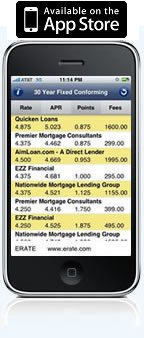Mortgage News
Mortgages
More borrowers reach for ARMs
by Broderick Perkins
(3/23/2011) - When the mortgage meltdown submerged housing and took the economy with it, adjustable rate mortgages' (ARMs) penchant for skyrocketing in cost made them the bane of home owners' existence.
Now much less toxic, but still risky for some borrowers, they are making a small comeback.
ARMs once accounted for 60 to 70 percent of all mortgages in some product categories, but the share of ARMs crashed to below 3 percent by 2009, according to a Federal Bank of New York report.
Today, however, ARMs comprise from 5 to 7 percent in some mortgage product categories, according to numbers from Freddie Mac and the Mortgage Bankers Association.
Bank of America recently reported to the New York Times ARMs now account for 10 percent of all its home loans.
The draw of ARMs is that they come with a rate that's initially lower than fixed rate mortgages (FRMS).
The average fixed interest rate on conforming 30-year mortgages came in at 4.99 percent the week ending March 22, according to the weekly Erate Interest Rate Update.
Compare that to the 3.21 percent rate for 5/1 ARMs, loans that remain the same for five years and then change each year after the fifth year. Some 5/1 ARMs were as low as 2.65 percent during the period.
ARMs come with a starting rate for a given period. The rate remains the same, typically, from six months or one year to 10 years. After the initial period, the rate changes, typically each year. A "5/1" ARM, for example, is fixed for five years and then resets each year thereafter.
How much the rate changes depends upon the "index," which can rise and fall; "margins," which, when attached to the index, add up to your current interest rate; and maximums or "caps" that limit the size of the rate increase during each period and how high the rate can go during the life of the loan. "Floors" also limit how low a rate can go.
Because the margin is set with the terms of the loan, the interest rate is at the mercy of the index.
ARMs failed for many borrowers because they came with features that proved too risky for some home owners. The idea of ARMs is they allow you to get into a mortgage for less than you'd normally pay, but months or years down the road, your increasing income would allow you to keep up with the adjustments to higher rates.
But both lenders and borrowers cheated, biting off more than they could chew.
Among the most notorious ARMs, was the "option ARM" that allowed borrowers the option to pay less than the monthly interest. That was fine as long as values appreciated, but when values plummeted, option ARMs left home buyers in negative amortization limbo, a position where the mortgage balance rose, while the home value sank, creating an "underwater" situation many home owners face today. An "underwater" mortgage is one that is larger than the home value.
Other ARMs came with short teaser rates that adjusted every six months, typically up, even as home values were falling and chipping away at equity. Even long term hybrid ARMs 3/1s, 5/1s, 7/1s and the like came with adjustments that tripled some mortgage payments at the original adjustment time, depending upon when the loan originated.
This time around, lenders are rolling out more conservative ARM products they claim to be "prime" loan products without "teaser" rates and option pay terms.
Most in demand are the 5/1 and 7/1 hybrids that begin around 3 percent and stay put for five or seven years, giving borrowers time to prepare for any adjustment, five to seven years down the road.
Refinance at Today's Low Rates!
Other Articles:
Mortgage applications surged last week
Higher market risk-based mortgage fees coming
Fannie Mae & Jumbo Mortgage Rates
Just One Click! = Current Rate Chart

Start by selecting your state
Get the Updated and Improved Mortgage Rates App from ERATE.com
- Why housing consumers say you need a real estate agent
- Lenders Double Down on Car-Title Loans Attempting to Stay Ahead of Regulators
- Need Cash Fast? Beware of Greedy Lenders Waiting to Exploit You
- Mortgage Rates and the Stock Market: Understanding the Relationship
- The ERATE® Resource Guide to No-Closing-Cost Refinancing
- You and Your Credit; Make it a Happy Ongoing Relationship
- Principal Reduction: New Programs, More Controversy
- Understanding Mortgages: Mortgage Paperwork
- What is Mortgage Interest?
- Mortgage Terms & Definitions
- Understanding Mortgages: Types of Mortgages
- Understanding Mortgages: How to Get a Mortgage
- What is a Short Sale?
- Understanding Mortgages: Buy or Rent?
- Understanding Mortgages: Working with a Real Estate Agent
- Understanding Mortgages: Working with a Real Estate Agent
- Understanding Credit Cards: Top Mistakes
FREE Mortgage Rate Widgets
Your State's Rates or National Rates Get this Widget for any State you want

